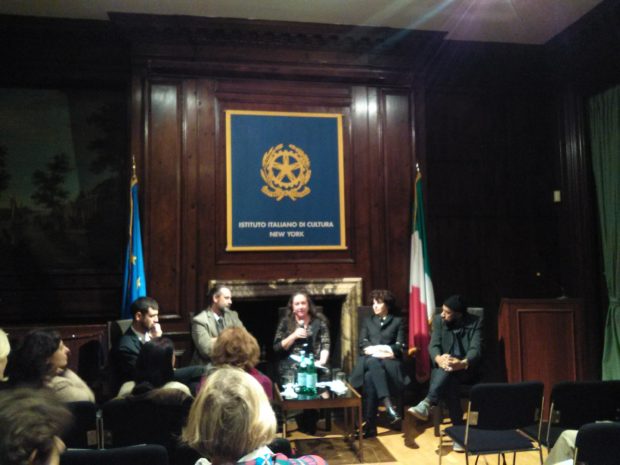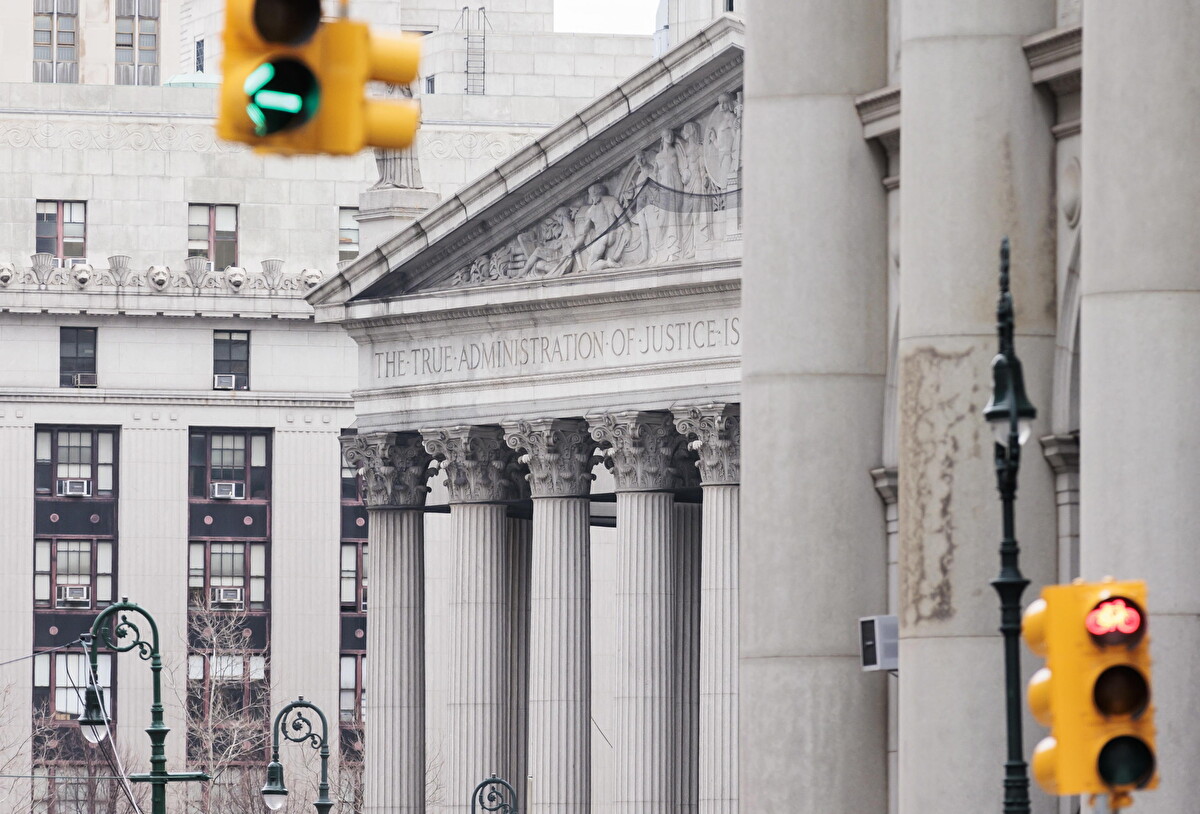On November 16, 2017, the Italian Cultural Institute of New York hosted a rare conversation. Four artists — two Americans, one Italian-American and one Italian — have discussed their experience as Fellows at the American Academy in Rome.
Carl D’Alvia, Tomaso De Luca, Jackie Saccoccio and Nari Ward, together with Giuseppe Stampone and Eugenio Tibaldi, are part of Now Here Is Nowhere: Six Artists from the American Academy in Rome, an exhibition kicked off at the Institute in partnership with the American Academy in Rome on November 7, to be enjoyed through December 5 on the mezzanine and first floor of the Institute.


It is the first time these two institutions bridging Italy and America work together. And if this is the outcome of a first collaboration, we can but anticipate fireworks for the next ones hopefully to come.
We attended both the opening and the conversation including D’Alvia, Saccoccio, De Luca and Ward. On both occasions, the interest in the audience was genuine and palpable. People lingering before artworks, perusing, talking to the artists, listening carefully. When someone stands before a work of art more for than three minutes, their face shaped in wonder or puzzlement, you can tell they are hooked. In front of Stampone’s Allez le Bleu, and Eugenio Tibaldi’s digital print Questione d’appartenenza 03, for instance, you could definitely say they were hooked. The same attention was paid during the conversation on Thursday 16: no fingers fumbling to retrieve a smart-phone, no clocks checked. The audience was all ears.
Founded in 1894 and located in beautiful Villa Aurelia on the Janiculum Hill, the American Academy in Rome is the main American overseas center for independent studies and advanced research in the fine arts and humanities. “We wanted to bring here some of the color of what happens at the Academy in Rome,” said Mark Robbins, President of the Academy in the introductory remarks.
“The Academy has put in place a new strategy: selecting Italian curators that could select Italian artists,” added Prof. Robbins with regard to the inception of the exhibition. Chosen for Now Here Is Nowhere, Italian curator Christian Caliandro spoke right after AAR President. “The show is direct descendant of two successive shows, The Idea of Realism and Concrete Ghost, both in the context of Cinque Mostre, the annual winter exhibition originated at the American Academy of Rome. This exhibition really represents the creative dialogue going on in the Academy, and also aims at celebrating the peripheral, the marginal, through the artworks of American, Italian and Italian-American artists.”
By taking inspiration, for its title, from a song by the Secret Machines, a New York trio band, Now Here Is Nowhere plays with the paradoxical idea of presence/absence in our hic-et-nunc through thirteen art pieces, which question certainty while asking the onlooker to familiarize with its negative, uncertainty, and be ready — as Caliandro puts it — “to always be somewhere else.”

For those who are not familiar with this prestigious institution, the Academy offers fellowships in all phases of Italy’s history and culture, from the ancient world to modern times: each year, through its Rome Prize competition, AAR awards twelve fellowships for research in Ancient Studies, Medieval Studies, Renaissance and Early Modern Studies, and Italian Studies.
“The Academy brings together 13 disciplines, by fostering dialogue among them”, underscored President Robbins, before leaving the floor to the conversation. “It is incredibly important to open up venues for discussion, especially in these times”, and was pleased to note that the Conversations, in addition to Rome and New York City, have also taken place in Philadelphia and Chicago. “I always think about the incredible interaction between American artists and scholars and Italian artists and scholars, and how Americans can bring new perspectives on Italian art.”


The conversation among the four artists was moderated by Vivien Greene, Guggenheim curator since 1993 and specialized in late 19th- and early 20th-century European art, with concentrations in Italian modernism and international currents in turn-of-the-century art and culture.
Each artist was very generous in the way they elaborated and shared their individual stay in Rome. “Every place has a particular kind of rhythm — Rome, New York City, every place does have it. It took me a bit to figure out the rhythm of Rome. But I eventually made it. As an artist who collects stuff around, I am attracted by chance. And in Rome I felt that endless stories were at my hand at every corner”, said Nari Ward, Jamaican-American artist based in NYC, who creates sculptural installations by turning everyday waste into unprecedented fantastical objects on the line of Arte Povera — a movement admired by the artist. “What I cherish was the idea of having other artists unfold art. Talking to other artists was important: it was a sort of oral history passing down to you”, said Jackie Saccoccio, renowned for her series of portraits combining clashing styles of application, including dripping, blurring, spilling and smudging. “And you also benefit

from all the ‘permessi’ — special passes — to visit Palatino, and venues we could visit as AAR Fellows!”
For Italian-American Carl D’Alvia, whose resin, bronze and marble sculptures range from the abstract and geometric to the figurative and anthropomorphic, as in the piece Patches, “Rome is a place of inspiration and change, offering incredible palinsesti of different genres and times together. And the Academy itself is a special space. It is in Rome, but it is American. Its staff is Italian but the people who live there are not. It’s its liminality, that is special. Like the Italian Cultural Institute, which is not a gallery, not a museum, but can actually be both. They are spaces in-between, which activate a special energy and house dialogue, interchange.”
Working in drawing, sculpture, installation, performance and video, Tomaso De Luca is the Italian artist of the lot: born in Verona, he relocated to the Capital.

“Rome was a city I chose. It is a city that is collapsing on itself. You can find it very violent — and I say it as an Italian. I come from Tor Pignattara, a very very different area compared to Villa Aurelia… To look at the city through the Fellowship was to see it through a different lens, through another culture. It gave me distance, and also the chance to negotiate with the masters. Italian art can be a burden, especially if you are an artist — how can you relate to such masters as Caravaggio?”. Questioned about his relationship with New York City, Tomaso said, “In Italy there is not enough space to experiment. New York City gave me the confidence to try, and also the feeling of finding other people like me.”
Fabio Troisi, Attaché for Cultural Affairs – Visual Arts and Performing Arts, within the Italian Cultural Institute, closes the evening by emphasizing how Director Van Straten has been crucial in the direction taken by the Institute. “Giorgio Van Straten conceives the Italian Cultural Institute as a place of dialogue with American institutions, not just as a gathering space for Italians or Italian-Americans.”
If we think of it, the agenda pursued by both institutions finds an artistic objective correlative in the exhibition itself, which intends to praise the encounter, the crossover, between American and Italian artists.
Our hope is that AAR and ICI will cross roads again. Soon.











